Moesia
Full Member
Quick guide to basic mineral recognition to get you started. Click on the images to enlarge.
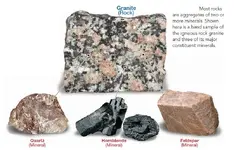
In contrast to minerals, rocks are more loosely defined. Simply, a rock is any solid mass of mineral, or mineral-like, matter that occurs naturally as part of our planet. Most rocks, like the common rock granite shown in Picture 1, occur as aggregates of several different minerals. The term aggregate implies that the minerals are joined in such a way that their individual properties are retained. Note that the mineral constituents of granite can be easily identified. However, some rocks are composed almost entirely of one mineral. A common example is the sedimentary rock limestone, which consists of impure masses of the mineral calcite.
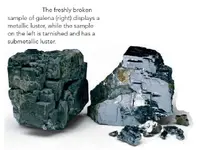
LUSTER. The appearance or quality of light reflected from the surface of a mineral is known as luster. Minerals that have the appearance of metals, regardless of color, are said to have a metallic luster (Picture 2). Some metallic minerals, such as native copper and galena, develop a dull coating or tarnish when exposed to the atmosphere. Because they are not as shiny as samples with freshly broken surfaces, these samples are often said to exhibit a submetallic luster. Most minerals have a nonmetallic luster and are described using various adjectives such as vitreous or glassy. Other nonmetallic minerals are described as having a dull or earthy luster (a dull appearance like soil) or a pearly luster (such as a pearl or the inside of a clamshell). Still others exhibit a silky luster (like satin cloth) or a greasy luster (as though coated in oil).
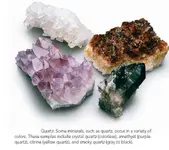
THE ABILITY TO TRANSMIT LIGHT. Another optical property used in the identification of minerals is the ability to transmit light. When no light is transmitted, the mineral is described as opaque; when light, but not an image, is transmitted through a mineral it is said to be translucent. When both light and an image are visible through the sample, the mineral is described as transparent.
COLOR. Although color is generally the most conspicuous characteristic of any mineral, it is considered a diagnostic property of only a few minerals. Slight impurities in the common mineral quartz, for example, give it a variety of tints including pink, purple, yellow, white, gray, and even black (Picture 3). Other minerals, such as tourmaline, also exhibit a variety of hues, with multiple colors sometimes occurring in the same sample. Thus, the use of color as a means of identification is often ambiguous or even misleading.
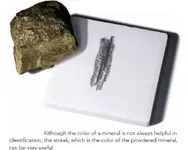
STREAK. The color of the mineral in powdered form, called streak, is often useful in identification. A mineral’s streak is obtained by rubbing it across a streak plate (a piece of unglazed porcelain) and observing the color of the mark it leaves (Picture 4). Although the color of a mineral may vary from sample to sample, its streak is usually consistent in color. Streak can also help distinguish between minerals with metallic luster and those with nonmetallic luster. Metallic minerals generally have a dense, dark streak, whereas minerals with nonmetallic luster typically have a light colored streak. It should be noted that not all minerals produce a streak when rubbed across a streak plate. For example, the mineral quartz is harder than a porcelain streak plate. Therefore, no streak is observed using this method.
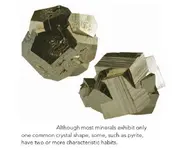
Mineralogists use the term crystal shape or habit to refer to the common or characteristic shape of a crystal or aggregate of crystals. A few minerals exhibit somewhat regular polygons that are helpful in their identification For example, magnetite crystals sometimes occur as octahedrons, garnets often form dodecahedrons, and halite and fluorite crystals tend to grow as cubes or near cubes. While most minerals have only one common habit, a few have two or more characteristic crystal shapes such as the pyrite sample shown in Picture 5.
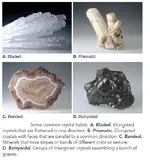
By contrast, some minerals rarely develop perfect geometric forms. Many of these, however, develop other characteristic shapes useful for identification. Some minerals tend to grow equally in all three dimensions, whereas others tend to be elongated in one direction, or flattened if growth in one dimension is suppressed. Commonly used terms to describe these and other crystal habits include equant (equidimensional), bladed, fibrous, tabular prismatic, platy, blocky, and botryoidal. Some of these habits are pictured in Picture 6.
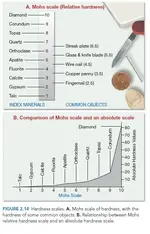
HARDNESS. One of the most useful diagnostic properties is hardness, a measure of the resistance of a mineral to abrasion or scratching. This property is determined by rubbing a mineral of unknown hardness against one of known hardness, or vice versa. A numerical value of hardness can by obtained by using the Mohs scale of hardness, which consists of 10 minerals arranged in order from 1 (softest) to 10 (hardest), as shown in Picture 7a. It should be noted that the Mohs scale is a relative ranking, and it does not imply that mineral number 2, gypsum, is twice as hard as mineral 1, talc. In fact, gypsum is only slightly harder than talc, as Picture 7b indicates. Other common objects can be used to determine the hardness of a mineral. These include a human fingernail, which has a hardness of about 2.5, a copper penny (3.5), and a piece of glass (5.5). The mineral gypsum, which has a hardness of 2, can be easily scratched with a fingernail. On the other hand, the mineral calcite, which has a hardness of 3, will scratch a fingernail but will not scratch glass. Quartz, one of the hardest common minerals, will easily scratch glass. Diamonds, hardest of all, scratch anything, including other diamonds.
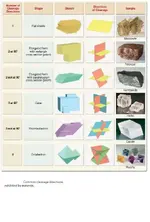
CLEAVAGE. In the crystal structure of many minerals, some atomic bonds are weaker than others. It is along these weak bonds that minerals tend to break when they are stressed. Cleavage is the tendency of a mineral to break (cleave) along planes of weak bonding. Not all minerals have cleavage, but those that do can be identified by the relatively smooth, flat surfaces that are produced when the mineral is broken. The simplest type of cleavage is exhibited by the micas. Because these minerals have very weak bonds in one direction, they cleave to form thin, flat sheets. Some minerals have excellent cleavage in one, two, three, or more directions, whereas others exhibit fair or poor cleavage, and still others have no cleavage at all. When minerals break evenly in more than one direction, cleavage is described by the number of cleavage directions and the angle(s) at which they meet (Picture 8). Each cleavage surface that has a different orientation is counted as a different direction of cleavage. For example, some minerals cleave to form six-sided cubes. Because cubes are defined by three different sets of parallel planes that intersect at 90-degree angles, cleavage is described as three directions of cleavage that meet at 90 degrees. Do not confuse cleavage with crystal shape. When a mineral exhibits cleavage, it will break into pieces that all have the same geometry. By contrast, the smooth-sided quartz crystals do not have cleavage. If broken, they fracture into shapes that do not resemble one another or the original crystals.
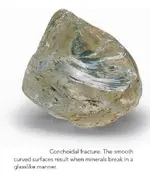
FRACTURE. Minerals having chemical bonds that are equally, or nearly equally, strong in all directions exhibit a property called fracture. When minerals fracture most produce uneven surfaces and are described as exhibiting irregular fracture. However, some minerals, such as quartz, break into smooth, curved surfaces resembling broken glass. Such breaks are called conchoidal fractures (Picture 9). Still other minerals exhibit fractures that produce splinters or fibers that are referred to as splintery and fibrous fracture, respectively.
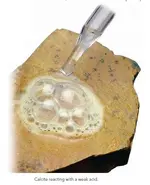
In addition to the properties discussed thus far, some minerals can be recognized by other distinctive properties. For example, halite is ordinary salt, so it can be quickly identified through taste. Talc and graphite both have distinctive feels; talc feels soapy, and graphite feels greasy. Further, the streaks of many sulfur-bearing minerals emit odors like rotten eggs. A few minerals, such as magnetite, have a high iron content and can be picked up with a magnet, while some varieties (lodestone) are natural magnets and will pick up small iron-based objects such as pins and paper clips. One very simple chemical test involves placing a drop of dilute hydrochloric acid from a dropper bottle onto a freshly broken mineral surface. Using this technique, certain minerals, called carbonates, will effervesce (fizz) as carbon dioxide gas is released (Picture 10). This test is especially useful in identifying the common carbonate mineral calcite.
Density, an important property of matter, is defined as mass per unit volume. Mineralogists often use a related measure called specific gravity to describe the density of minerals. Specific gravity is a number representing the ratio of a mineral’s weight to the weight of an equal volume of water. Most common rock-forming minerals have a specific gravity of between 2 and 3. For example, quartz has a specific gravity of 2.65. By contrast, some metallic minerals such as pyrite, native copper, and magnetite are more than twice as dense and thus have more than twice the specific gravity as quartz. Galena, an ore of lead, has a specific gravity of roughly 7.5, whereas the specific gravity of 24-karat gold is approximately 20. With a little practice, you can estimate the specific gravity of a mineral by hefting it in your hand. Ask yourself does this mineral feel about as “heavy” as similar sized rocks you have handled? If the answer is “yes,” the specific gravity of the sample will likely be between 2.5 and 3.
Ask me about anything that is not clear. Or you notice a mistake in the text, then please inform me.
PM me if you don't want to post

In contrast to minerals, rocks are more loosely defined. Simply, a rock is any solid mass of mineral, or mineral-like, matter that occurs naturally as part of our planet. Most rocks, like the common rock granite shown in Picture 1, occur as aggregates of several different minerals. The term aggregate implies that the minerals are joined in such a way that their individual properties are retained. Note that the mineral constituents of granite can be easily identified. However, some rocks are composed almost entirely of one mineral. A common example is the sedimentary rock limestone, which consists of impure masses of the mineral calcite.

LUSTER. The appearance or quality of light reflected from the surface of a mineral is known as luster. Minerals that have the appearance of metals, regardless of color, are said to have a metallic luster (Picture 2). Some metallic minerals, such as native copper and galena, develop a dull coating or tarnish when exposed to the atmosphere. Because they are not as shiny as samples with freshly broken surfaces, these samples are often said to exhibit a submetallic luster. Most minerals have a nonmetallic luster and are described using various adjectives such as vitreous or glassy. Other nonmetallic minerals are described as having a dull or earthy luster (a dull appearance like soil) or a pearly luster (such as a pearl or the inside of a clamshell). Still others exhibit a silky luster (like satin cloth) or a greasy luster (as though coated in oil).

THE ABILITY TO TRANSMIT LIGHT. Another optical property used in the identification of minerals is the ability to transmit light. When no light is transmitted, the mineral is described as opaque; when light, but not an image, is transmitted through a mineral it is said to be translucent. When both light and an image are visible through the sample, the mineral is described as transparent.
COLOR. Although color is generally the most conspicuous characteristic of any mineral, it is considered a diagnostic property of only a few minerals. Slight impurities in the common mineral quartz, for example, give it a variety of tints including pink, purple, yellow, white, gray, and even black (Picture 3). Other minerals, such as tourmaline, also exhibit a variety of hues, with multiple colors sometimes occurring in the same sample. Thus, the use of color as a means of identification is often ambiguous or even misleading.

STREAK. The color of the mineral in powdered form, called streak, is often useful in identification. A mineral’s streak is obtained by rubbing it across a streak plate (a piece of unglazed porcelain) and observing the color of the mark it leaves (Picture 4). Although the color of a mineral may vary from sample to sample, its streak is usually consistent in color. Streak can also help distinguish between minerals with metallic luster and those with nonmetallic luster. Metallic minerals generally have a dense, dark streak, whereas minerals with nonmetallic luster typically have a light colored streak. It should be noted that not all minerals produce a streak when rubbed across a streak plate. For example, the mineral quartz is harder than a porcelain streak plate. Therefore, no streak is observed using this method.

Mineralogists use the term crystal shape or habit to refer to the common or characteristic shape of a crystal or aggregate of crystals. A few minerals exhibit somewhat regular polygons that are helpful in their identification For example, magnetite crystals sometimes occur as octahedrons, garnets often form dodecahedrons, and halite and fluorite crystals tend to grow as cubes or near cubes. While most minerals have only one common habit, a few have two or more characteristic crystal shapes such as the pyrite sample shown in Picture 5.

By contrast, some minerals rarely develop perfect geometric forms. Many of these, however, develop other characteristic shapes useful for identification. Some minerals tend to grow equally in all three dimensions, whereas others tend to be elongated in one direction, or flattened if growth in one dimension is suppressed. Commonly used terms to describe these and other crystal habits include equant (equidimensional), bladed, fibrous, tabular prismatic, platy, blocky, and botryoidal. Some of these habits are pictured in Picture 6.

HARDNESS. One of the most useful diagnostic properties is hardness, a measure of the resistance of a mineral to abrasion or scratching. This property is determined by rubbing a mineral of unknown hardness against one of known hardness, or vice versa. A numerical value of hardness can by obtained by using the Mohs scale of hardness, which consists of 10 minerals arranged in order from 1 (softest) to 10 (hardest), as shown in Picture 7a. It should be noted that the Mohs scale is a relative ranking, and it does not imply that mineral number 2, gypsum, is twice as hard as mineral 1, talc. In fact, gypsum is only slightly harder than talc, as Picture 7b indicates. Other common objects can be used to determine the hardness of a mineral. These include a human fingernail, which has a hardness of about 2.5, a copper penny (3.5), and a piece of glass (5.5). The mineral gypsum, which has a hardness of 2, can be easily scratched with a fingernail. On the other hand, the mineral calcite, which has a hardness of 3, will scratch a fingernail but will not scratch glass. Quartz, one of the hardest common minerals, will easily scratch glass. Diamonds, hardest of all, scratch anything, including other diamonds.

CLEAVAGE. In the crystal structure of many minerals, some atomic bonds are weaker than others. It is along these weak bonds that minerals tend to break when they are stressed. Cleavage is the tendency of a mineral to break (cleave) along planes of weak bonding. Not all minerals have cleavage, but those that do can be identified by the relatively smooth, flat surfaces that are produced when the mineral is broken. The simplest type of cleavage is exhibited by the micas. Because these minerals have very weak bonds in one direction, they cleave to form thin, flat sheets. Some minerals have excellent cleavage in one, two, three, or more directions, whereas others exhibit fair or poor cleavage, and still others have no cleavage at all. When minerals break evenly in more than one direction, cleavage is described by the number of cleavage directions and the angle(s) at which they meet (Picture 8). Each cleavage surface that has a different orientation is counted as a different direction of cleavage. For example, some minerals cleave to form six-sided cubes. Because cubes are defined by three different sets of parallel planes that intersect at 90-degree angles, cleavage is described as three directions of cleavage that meet at 90 degrees. Do not confuse cleavage with crystal shape. When a mineral exhibits cleavage, it will break into pieces that all have the same geometry. By contrast, the smooth-sided quartz crystals do not have cleavage. If broken, they fracture into shapes that do not resemble one another or the original crystals.

FRACTURE. Minerals having chemical bonds that are equally, or nearly equally, strong in all directions exhibit a property called fracture. When minerals fracture most produce uneven surfaces and are described as exhibiting irregular fracture. However, some minerals, such as quartz, break into smooth, curved surfaces resembling broken glass. Such breaks are called conchoidal fractures (Picture 9). Still other minerals exhibit fractures that produce splinters or fibers that are referred to as splintery and fibrous fracture, respectively.

In addition to the properties discussed thus far, some minerals can be recognized by other distinctive properties. For example, halite is ordinary salt, so it can be quickly identified through taste. Talc and graphite both have distinctive feels; talc feels soapy, and graphite feels greasy. Further, the streaks of many sulfur-bearing minerals emit odors like rotten eggs. A few minerals, such as magnetite, have a high iron content and can be picked up with a magnet, while some varieties (lodestone) are natural magnets and will pick up small iron-based objects such as pins and paper clips. One very simple chemical test involves placing a drop of dilute hydrochloric acid from a dropper bottle onto a freshly broken mineral surface. Using this technique, certain minerals, called carbonates, will effervesce (fizz) as carbon dioxide gas is released (Picture 10). This test is especially useful in identifying the common carbonate mineral calcite.
Density, an important property of matter, is defined as mass per unit volume. Mineralogists often use a related measure called specific gravity to describe the density of minerals. Specific gravity is a number representing the ratio of a mineral’s weight to the weight of an equal volume of water. Most common rock-forming minerals have a specific gravity of between 2 and 3. For example, quartz has a specific gravity of 2.65. By contrast, some metallic minerals such as pyrite, native copper, and magnetite are more than twice as dense and thus have more than twice the specific gravity as quartz. Galena, an ore of lead, has a specific gravity of roughly 7.5, whereas the specific gravity of 24-karat gold is approximately 20. With a little practice, you can estimate the specific gravity of a mineral by hefting it in your hand. Ask yourself does this mineral feel about as “heavy” as similar sized rocks you have handled? If the answer is “yes,” the specific gravity of the sample will likely be between 2.5 and 3.
Ask me about anything that is not clear. Or you notice a mistake in the text, then please inform me.
PM me if you don't want to post
Amazon Forum Fav 👍
Last edited:



